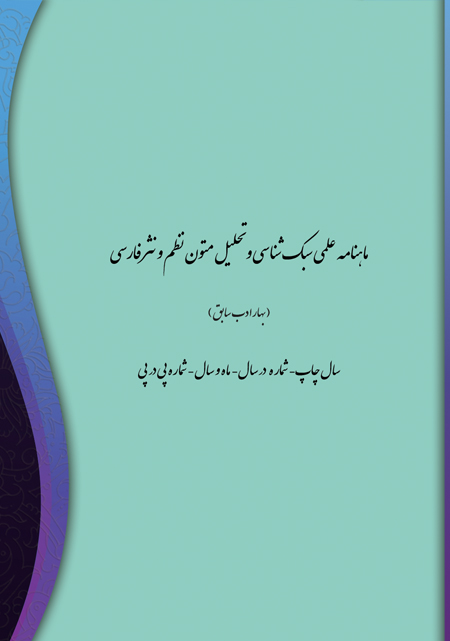- Count View : 9
- آدرس کوتاه شده مقاله: https://bahareadab.com/article_id/1875
- کد doi مقاله: Doi: 10.22034/bahareadab.2025 .18 .7909
Journal of the stylistic of Persian poem and prose
volume Number 18،
number In Volume 6،
،
issue Number 112
Analysis of Focalization Techniques in the Story of “Khosrow and Shirin” by Nezami Ganjavi
Mina Ghasemi Ebrahimabadi , Mohammad Sadegh Basiri (Author in Charge), Najmeh Hosseini Sarvari
Abstract
BACKGROUND AND OBJECTIVES: "Focalization" – a pivotal concept in Gérard Genette"s structuralist narratology – examines the regulation of perspectives and distribution of information within narrative discourse, playing a central role in analyzing literary narrative structures. Genette"s fundamental distinction between two principal narrative agents:
The observer of events (experiencing subject)
The narrator of occurrences (narrating voice)
defines two discrete functional operations in the narrative framework:
The process of verbal enunciation
The process of visual perception.
Functioning as a mediating mechanism between audience and textual fabric, the focalizing agent (the operative logic directing focalization) operates through multidimensional planes—perceptual, psychological, and ideological—with variable parameters that actively configure audience perception, thereby generating distinctive hermeneutic effects.
METHODOLOGY: This research Analyzes the mechanisms of focalization employed to explore the knowledge distribution within the narrative of Nezami Ganjavi"s epic poem, "Khosrow and Shirin."
FINDINGS: When the communicative framework arising from narration is structured and orchestrated by an agent known as the narrator, Nezami constructs a system of specific intellectual and cultural components. These components, across different periods, convey significant messages that can lead us to certain identity-forming elements.
CONCLUSION: The findings of this research indicate that the narrator-focalizer, constrained by the direct transmission of thought from the dominant voice/omniscient narrator, who propagates a singular ideology, creates a significant distance from the text"s communicative framework (Nezami"s construct, shaped by the interaction between the audience, narrator, and characters). This, in turn, diminishes the reader"s sense of unity with the work, consequently leading to the formation of a monophonic structure. The observation and narration of event sequences by the narrator-focalizer, and the utilization of various aspects of external focalization as the most frequent technique employed in the narrative, are arranged in such a way that, in most cases, the reader possesses more information than the characters. This generates a dual feeling of suspense and curiosity, alongside ambiguity and a disruption of the continuity of action sequences in the story, within the reader"s mind.
Keyword
Narratology
, Khosrow and Shirin
, Nezami Ganjavi
, Gérard Genette
, focalization.
- Eagleton, T. (1989). Literary Theory: An Introduction (A. Mokhber, Trans.). Tehran: Markaz Publishing.
- Bertens, J. W. (2003). Literary Theory (F. Sojoodi, Trans.). Tehran: Ahang-e Digar Publishing.
- Bordwell, D. (2017). Narration in the Fiction Film (Vol. 1, S. A. Tabatabai, Trans., 3rd ed.). Tehran: Farabi Cinema Foundation.
- Branigan, E. (2017). Understanding Narrative and Film (S. J. Shahroudi Langroudi, Trans.). Tehran: Siahrood Publications.
- Tyson, L. (2008). Contemporary Literary Criticism Theories (M. Hosseinzadeh & F. Hosseini, Trans.). Tehran: Negahe Emrooz Publishing.
- Toolan, M. (2007). Narratology: A Linguistic-Critical Introduction (S. F. Alavi & F. Nemat, Trans.). Tehran: SAMT Publications.
- Dastgerdi, V. (1999). Khosrow and Shirin. Tehran: Ghatreh Publishing.
- Zolfaghari, H. (2013). One Hundred Persian Love Narratives. Tehran: Charkh Publications.
- Zarrinkoob, A. (2016). Pir-e Ganjeh in Search of Utopia. Tehran: Sokhan Publications.
- Safa, Z. (1987). History of Literature in Iran (Vol. 2). Tehran: Ferdows Publications.
- Currie, G. (2016). Narratives and Narrators (M. Shahba, Trans., 2nd ed.). Tehran: Minoye Kherad Publishing.
- Guerin, W., et al. (2009). An Introduction to Literary Criticism Methods (A. Farahbakhsh & Z. Heidari Moghaddam, Trans.). Tehran: Rahnam Publications.
- Lothe, J. (2009). An Introduction to Narrative in Literature and Cinema (O. Nikfar, Trans., 2nd ed.). Tehran: Minoye Kherad Publishing.
- Martin, W. (2003). Narrative Theories (M. Shahba, Trans.). Tehran: Hermes Publications.
- McQuillan, M. (2009). Selected Articles on Narrative (F. Mohammadi, Trans.). Tehran: Minoye Kherad Publishing.
- Jahn, M. (2019). Narratology (M. Ragheb, Trans., 2nd ed.). Tehran: Ghoghnos Publications.
- Articles:
- Azhari, M., Torabi, M. R., Malmir, T., & Hajiian Nejad, A. (2019). Analysis of the Narrative Structure of the Story of Khosrow and Shirin by Nezami. Literary Criticism and Rhetoric Research Journal, 8(2), 17-35.
- Sardaghi, M. H., & Shahrami, M. B. (2015). Examining the Element of Point of View in Nezami's Khosrow and Shirin Based on Gérard Genette's Narratology Model. Literary and Rhetorical Researches, 13, 99-116.
- Safaa, Parvaneh; Sharifpoor, Enayatollah; Jafari, Maryam (2022). ‘Study and analysis of literary types in Nezami Ganjavi poems’ Journal of the Stylistics of Persian Poem and Prose, Volume 15, Issue 6, September 2022, Issue 76
- Ghorbani, F., & Gholamrezaei, M. (2017). Analyzing the Time Structure in Nezami Ganjavi's Khosrow and Shirin Based on Genette's Model of Time and Narrative. Interpretation and Analysis of Persian Language and Literature Texts (Dehkhoda), 9(33), 153-196.
- Karbalaie Sadegh, M., Seyed Ebrahimi Nejad, F., & Poordad, A. (2012). Point of View in the Tale of Khosrow and Shirin in Nezami Ganjavi's Narrative: A Semiotic-Semantic Approach. National Conference on Literary Criticism.
- Muti Shirazi, L., & Khaleghzadeh, M. H. (2016). Descriptive Techniques in Nezami Ganjavi's Khosrow and Shirin. International Conference on Islamic Humanities.
- Madaberi, M., Hosseini Sarvari, N., & Jafari, M. (2019). Focalization and Distribution of Knowledge in the Story of Khosrow and Shirin in Shahnameh. Modern Literary Essays, 204, 47-71.

